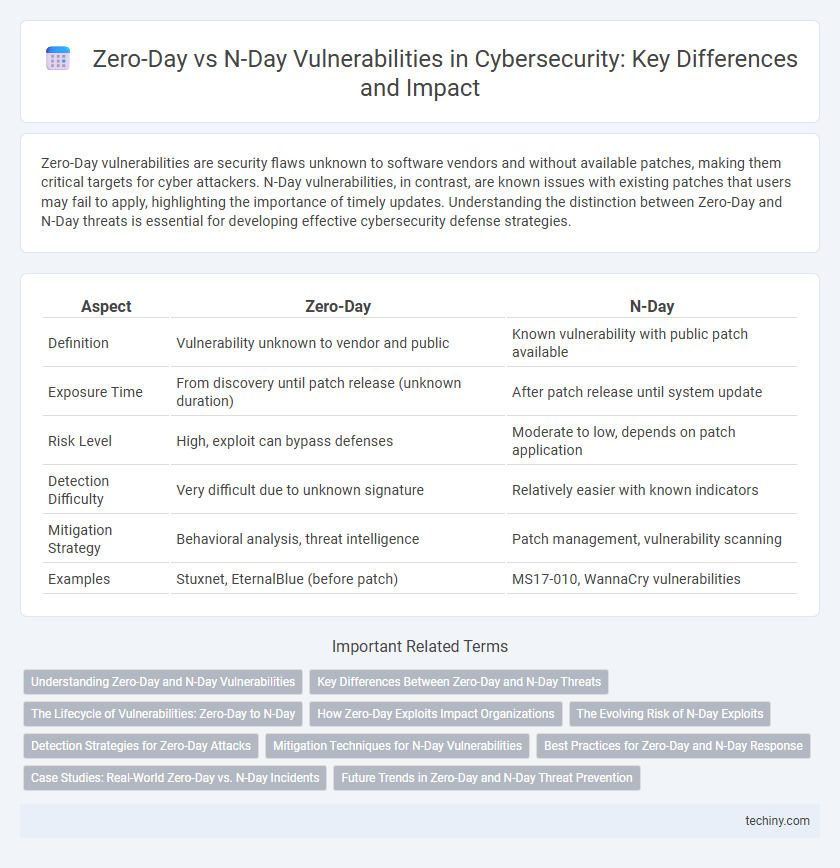Zero-Day vulnerabilities are security flaws unknown to software vendors and without available patches, making them critical targets for cyber attackers. N-Day vulnerabilities, in contrast, are known issues with existing patches that users may fail to apply, highlighting the importance of timely updates. Understanding the distinction between Zero-Day and N-Day threats is essential for developing effective cybersecurity defense strategies.
Table of Comparison
| Aspect | Zero-Day | N-Day |
|---|---|---|
| Definition | Vulnerability unknown to vendor and public | Known vulnerability with public patch available |
| Exposure Time | From discovery until patch release (unknown duration) | After patch release until system update |
| Risk Level | High, exploit can bypass defenses | Moderate to low, depends on patch application |
| Detection Difficulty | Very difficult due to unknown signature | Relatively easier with known indicators |
| Mitigation Strategy | Behavioral analysis, threat intelligence | Patch management, vulnerability scanning |
| Examples | Stuxnet, EternalBlue (before patch) | MS17-010, WannaCry vulnerabilities |
Understanding Zero-Day and N-Day Vulnerabilities
Zero-Day vulnerabilities refer to security flaws that are unknown to software vendors and have no available patches, making them highly exploitable by attackers. N-Day vulnerabilities, on the other hand, are known security issues with existing patches that organizations may neglect or delay applying, increasing the risk of compromise. Understanding the difference between Zero-Day and N-Day vulnerabilities is crucial for implementing effective threat mitigation and timely patch management strategies in cybersecurity.
Key Differences Between Zero-Day and N-Day Threats
Zero-Day threats exploit previously unknown vulnerabilities, leaving organizations without immediate patches or defenses, while N-Day threats target known vulnerabilities with existing fixes available. Zero-Day attacks pose higher risks due to the lack of prior detection and mitigation strategies, whereas N-Day threats can often be managed through timely software updates and security patches. Understanding the distinction between these threat types is essential for developing effective cybersecurity strategies and prioritizing resources for vulnerability management.
The Lifecycle of Vulnerabilities: Zero-Day to N-Day
Zero-day vulnerabilities exist from the moment a security flaw is discovered but remain unpatched, leaving systems exposed to unknown threats. Once a vendor releases a patch or mitigation, the vulnerability transitions into an N-day state, where it is publicly known and must be managed through timely updates and threat intelligence. Effective vulnerability lifecycle management involves rapid identification, patch deployment, and continuous monitoring to minimize exploitation risks throughout both zero-day and N-day phases.
How Zero-Day Exploits Impact Organizations
Zero-Day exploits pose significant risks to organizations by targeting vulnerabilities unknown to software vendors, leading to unpatched security gaps that hackers can exploit before detection or mitigation occurs. These attacks often result in data breaches, financial losses, and operational disruptions, significantly damaging an organization's reputation and trustworthiness. Unlike N-Day vulnerabilities, which are already identified and patched, Zero-Day threats require proactive threat intelligence and advanced intrusion detection systems to minimize impact and strengthen cybersecurity resilience.
The Evolving Risk of N-Day Exploits
N-Day exploits leverage known vulnerabilities with available patches, but attackers capitalize on the lag in deployment across organizations, making these exploits increasingly dangerous despite remediation efforts. The evolving risk of N-Day attacks stems from inconsistent patch management, delayed updates, and the growing sophistication of threat actors who repurpose old vulnerabilities in new attack vectors. Effective cybersecurity strategies require continuous vulnerability scanning, timely patch application, and proactive threat intelligence to mitigate the persistent risk posed by N-Day exploits.
Detection Strategies for Zero-Day Attacks
Zero-day attacks exploit unknown vulnerabilities, making traditional signature-based detection ineffective due to the absence of prior threat data. Behavioral analysis and anomaly detection techniques leverage machine learning to identify unusual patterns and activities indicative of zero-day exploits. Combining sandboxing environments with real-time monitoring enhances detection capabilities by isolating suspicious behaviors before they cause significant damage.
Mitigation Techniques for N-Day Vulnerabilities
Mitigation techniques for N-Day vulnerabilities center on rapid patch management and vulnerability scanning to identify and remediate known exploits efficiently. Utilizing intrusion detection systems (IDS) and endpoint protection platforms enables continuous monitoring and behavior analysis to prevent exploitation. Regular software updates combined with threat intelligence sharing improve defense mechanisms against the evolving attack surfaces of N-Day vulnerabilities.
Best Practices for Zero-Day and N-Day Response
Zero-Day and N-Day vulnerabilities require distinct but complementary response strategies to mitigate cyber risks effectively. Best practices for Zero-Day response emphasize rapid threat intelligence sharing, deploying heuristic-based detection systems, and implementing network segmentation to limit attack surfaces. For N-Day vulnerabilities, organizations should prioritize timely patch management, continuous vulnerability scanning, and thorough incident response planning to remediate known weaknesses efficiently.
Case Studies: Real-World Zero-Day vs. N-Day Incidents
Real-world case studies highlight the critical impact of zero-day vulnerabilities, such as the 2017 Equifax breach, where an unpatched zero-day exploit allowed attackers to access sensitive data. In contrast, N-day incidents like the WannaCry attack exploited known vulnerabilities with available patches, but widespread failure to update systems led to rapid global infection. These examples emphasize the importance of timely patch management and proactive threat intelligence in mitigating both zero-day and N-day cybersecurity risks.
Future Trends in Zero-Day and N-Day Threat Prevention
Zero-Day and N-Day threats are evolving rapidly, pushing cybersecurity technologies to prioritize adaptive, AI-driven detection and automated patch management systems. Future trends emphasize integrating machine learning algorithms that analyze behavioral patterns to identify unknown Zero-Day exploits while streamlining N-Day vulnerability assessments across complex networks. Embracing threat intelligence sharing platforms and zero-trust architectures will enhance early threat detection and reduce exposure windows effectively.
Zero-Day vs N-Day Infographic

 techiny.com
techiny.com